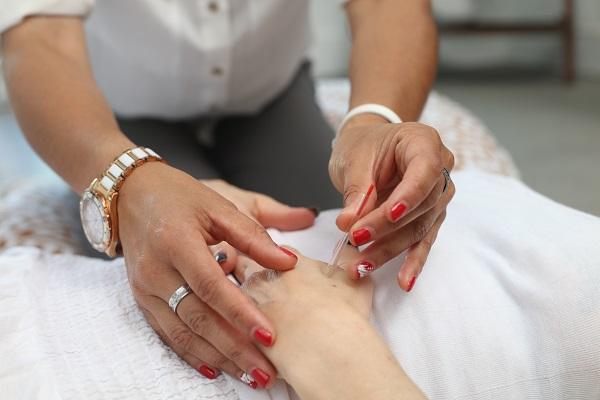Did You Know That There Are Non-Surgical Treatments for Provoked Vulvodynia (PVD)?
Provoked Vulvodynia affects approximately 10% of women
PVD is known as a chronic overlapping pain condition with endometriosis... While there are pharmacologic and surgical options, there are also other more conservative non-surgical treatments for provoked vulvodynia.
Provoked vulvodynia (PVD) is a chronic pain condition characterized by pain in the vulva when provoked by touch such as a tampon, speculum, clothing and/or sexual penetration. This condition affects approximately 10% in young women and can be truly debilitating. The etiology of PVD is complex and includes a combination of biologic and psychological factors. Other factors that may contribute to PVD are neural proliferation (an increase in nerve endings in the area), pelvic floor dysfunction, hormonal imbalances, recurrent infections, inflammation, high urinary oxalate levels and other psychological factors.
It is also a known chronic overlapping pain condition with endometriosis, however those with PVD do not necessarily have endometriosis. We see that those with preexisting disorders of depression or anxiety are four times more likely to develop PVD than those without. In addition, those who have been diagnosed with PVD are 10x more likely to develop anxiety disorders and 4x more likely to develop depression. While there are pharmacologic and surgical options, there are also other more conservative treatments to try if you suffer from PVD, including pelvic floor physical therapy, cognitive behavioral therapy, mindfulness and acupuncture.
Pelvic Floor Physical Therapy & PVD
Pelvic floor dysfunction is thought to be an influential factor in developing PVD.
Those who have trouble coordinating their pelvic floor muscle function may be consciously or unconsciously engaging their pelvic floor too often. This can lead to short and tight pelvic floor muscles. These muscles are working in overdrive and start to develop trigger points that can then lead to localized or generalized pain in the pelvic floor and vulva. Pelvic floor physical therapists would address the tight pelvic floor muscles and perform some gentle manual therapy techniques and teach you how to do pelvic floor releases at home with a tool. We provide education on vulvar hygiene and optimize bladder and bowel health. We would also give you an individualized program including stretches and strengthening exercises that would benefit you.
Cognitive behavioral therapy (CBT)
CBT addresses both psychological and social aspects of PVD. This approach focuses on increasing awareness and activity modification in response to pain. CBT has been shown to decrease pain intensity, improve physical functioning, coping, psychological distress, and mood. Studies also show that CBT significantly improved sexual functioning more than topical steroid treatments. As a bonus, depression and anxiety were reduced even after 1 year from completion of CBT treatment.
Mindfulness
 Mindfulness as a treatment course in dealing with symptoms of PVD, provoked vulvodynia.
Mindfulness as a treatment course in dealing with symptoms of PVD, provoked vulvodynia.
There are 4 elements of mindfulness: attention regulation, body awareness, emotional regulation, and change in perspective of self. Whereas CBT is a change-oriented strategy, mindfulness focuses on acceptance. Studies have shown that mindfulness significantly improves self-efficacy, pain hypervigilance, rumination, helplessness and magnification. In addition, resarch showed a consistent pattern of a decrease of fear of pain, which benefits the quality of life in patients dealing with PVD.
It is important to recognize that both CBT and mindfulness are not “quick fixes,” and do require time, dedication and patience. However, they are noninvasive and proven to be efficacious long term while providing a comprehensive biopsychosocial approach. It is not usually offered as first line treatment for PVD, but maybe it should be offered more routinely in conjunction with other treatments. Researchers have found that psychological factors play an instrumental role in treatment outcomes.
Chinese Herbs/Acupuncture
 From a Chinese medicine perspective, PVD is often seen as coming from imbalances of the liver, spleen, or kidney. More often than not, this one practitioner believes PVD stems from a liver qi stagnation. There are many herbal medicines that would help release liver qi stagnation: Chai Hu, Zhi Shi, Bai Shao, and Zhi Gan Cao to name a few. There are two case studies using a combination of herbal medicine and acupuncture to help with PVD and other common symptoms that go with PVD (such as digestive issues, menstrual dysregulation, etc.). These two women were able to achieve pain-free sexual intercourse, decrease vulvar irritation/itchiness, restore menstrual regularity, improve digestive symptoms and decrease stress/anxiety. It is recommended to have both herbal treatments with acupuncture sessions to maximize its potential for improvement in symptoms.
From a Chinese medicine perspective, PVD is often seen as coming from imbalances of the liver, spleen, or kidney. More often than not, this one practitioner believes PVD stems from a liver qi stagnation. There are many herbal medicines that would help release liver qi stagnation: Chai Hu, Zhi Shi, Bai Shao, and Zhi Gan Cao to name a few. There are two case studies using a combination of herbal medicine and acupuncture to help with PVD and other common symptoms that go with PVD (such as digestive issues, menstrual dysregulation, etc.). These two women were able to achieve pain-free sexual intercourse, decrease vulvar irritation/itchiness, restore menstrual regularity, improve digestive symptoms and decrease stress/anxiety. It is recommended to have both herbal treatments with acupuncture sessions to maximize its potential for improvement in symptoms.
Uterosacral ligament support
New research studied the hypothesis of improving PVD through uterosacral ligament support.
The uterosacral ligaments connect the uterus to the front of the sacrum (one on each side). It is known that these ligaments are part of the parasympathetic (“rest and digest”) and sympathetic (“fight or flight”) nervous systems, and authors wondered how these ligaments would affect someone’s PVD. In general, chronic pelvic pain is associated with a loss of the sympathetic plexus. The nerve fibers from the sympathetic plexus discontinue in a region that is very close to the vestibule, clitoris, Bartholin’s glands, and superficial vagina. The theory is that due to its connections to the plexuses, support of the ligaments could indirectly influence pain and hypersensitivity associated with PVD.
One study injected 10 women with PVD with an anesthetic in the uterosacral ligaments at their insertion point on the cervix. The majority of the women had at least 30 minutes of PVD relief. Another study used a swab stick to stretch the posterior fornix, providing temporary support to the ligaments. During this support, provoked vulvar pain was temporarily alleviated. Essentially, laxity of the uterosacral ligaments could be yet another contributor to PVD and should be ruled in/out as a factor, and thus a consideration factor towards your treatment plan.
Discuss Non-Surgical Treatments for Provoked Vulvodynia
As you can see, PVD can be a debilitating condition and not only affects us physically but also mentally and socially. While it may be very overwhelming to hear about the different treatments for PVD, it is important to know all the factors that may be contributing to your PVD to help best treat your individualized symptoms! On top of the standard first line treatments, it may be worth exploring different or combining types of treatments like physical therapy, CBT and acupuncture to embody a more biopsychosocial approach. Have any questions about non-surgical treatments for provoked vulvodynia? Having a pelvic floor physical therapist on your team can be truly beneficial in guiding you to the right practitioners and treatments. Give us a call or contact us for questions or an appointment.
References:
Craven MK, Thelen RL, Elliot L & Lazear J. Provoked Vulvodynia: A holistic Treatment Approach. J for Nurse Practitioners 2016;12(8): 530-535.
Schonfeld, M. Petros P & Bornstein J. Mechanically Supporting Uterosacral Ligaments for the Relief of Provoked Vulvodynia: A Randomized Pilot Trial. J of Pain Research 2021;14: 1281-1288.
Zilberman O. The Treatment of Vulvodynia with Acupuncture and Chinese Herbal Medicine. J of Chinese Med 2015;109:28-36.










